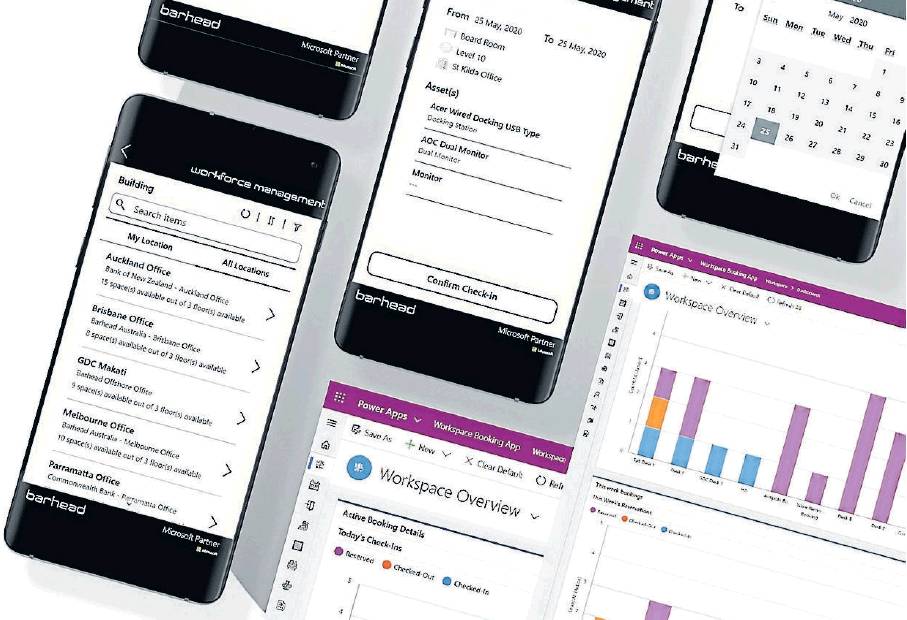Technology enabling a safe return to the office
As businesses continue to adapt to the ‘‘new normal’’ of staff working from home during the COVID-19 pandemic, some are already working through ways in which their people can safely return to the office.
Around two-thirds of working Australians – more than 10.5 million people – have been forced into an employment change because of the coronavirus, with a large proportion having been forced to work from home, according to Roy Morgan research.
As a result, many organisations have already decreed that staff shall work remotely until at least the end of the year, forcing some organisations to fast-track their digital transformation efforts, according to Microsoft chief executive Satya Nadella.
‘‘We’ve seen two years’ worth of digital transformation in two months,’’ Nadella says. ‘‘From remote teamwork and learning, to sales and customer service, to critical cloud infrastructure and security – we are working alongside customers every day to help them adapt and stay open for business in a world of remote everything.’’
The challenges of returning to the workplace will include ensuring safe distancing between employees and visitors, managing the flow of people in and out of the office, and planning for the use of collaboration spaces, meeting rooms and hot-desking, according to PwC.
A return to work, perhaps relying on parallel scheduling or shift work to separate teams, will require monitoring and maintaining proper social distancing guidelines. It will also require a riskmanagement process that factors in contact tracing, travel policy reviews and tracking of employee compliance with health regulations.
Organisations that ignore the national COVID-19 safe workplace principles and lack a robust COVIDsafe return-to-work plan will leave themselves open to further business disruptions, hefty fines from health and safety regulators, and potentially lawsuits from impacted employees.
These challenges don’t just affect front-line workers, they go to the very top, as the board needs confidence both that a return-to-work plan is in place and that staff are abiding by it.
Just as new technology is enabling people to stay productive while working from home, new and emerging technologies will also underpin efforts to safely bring them back into the office when the time is right, notes Ken Struthers, cofounder and chief executive of Microsoft Business Applications partner Barhead Solutions.
Workforce scheduling tools traditionally don’t drill down to the granular level of tracking desk usage, restricting the number of people in a meeting room or maintaining adequate social distancing in the office. Nor do they offer enough gradual data to support effective in-house contact tracing in the event of a staff member testing positive to COVID-19.
Not only do businesses need a COVIDsafe return-to-work plan but, from a compliance perspective, they also need to be able to guarantee that the plan is being executed and have the visibility to quickly address breaches. This is where digital transformation can extend into the physical office space, Struthers says.
‘‘The office is like a microcosm of society and businesses are going to face similar challenges when it comes to tracking where staff have been and who they have been in contact with,’’ he says.
‘‘To do this effectively you need to be able to manage teams and in-office collaboration, in order to quarantine departments or business units within the organisation.
‘‘If your people are spread across 10 floors, do you really need to close down the entire building because one person has a cough, or do you have the confidence to manage that risk at a more granular level?’’
Working with Microsoft’s Power Platform, Barhead Solutions’ Workforce Management App takes advantage of Dataflex Pro and Dataflex – a new low-code data platform for Microsoft Teams. It is essentially a relational database which empowers organisations to better manage their workforce in both the physical and digital realms.
The app is assisted by sensors spread around an office to monitor compliance and identify potential trouble spots, such as staff congregating in the lobby or overcrowding in meeting rooms. In the next phase of the project, this spatial awareness will be augmented by device-based tracking.
Building on this, Dataflex Pro – formerly known as Common Data Service – extends these capabilities to take advantage of Microsoft’s investments in artificial intelligence and advanced analytics.
With Dataflex Pro, Microsoft has surfaced much of its AI capabilities and made them agile and digestible not just for data scientists but for ‘‘mere mortals’’ – such as citizen developers and consultants – allowing them to quickly tackle advanced business problems, Struthers says.
‘‘These problems aren’t going away, so developing our Workforce Management App built on Power Platform’s underlying technologies is far more practical and effective than having COVID marshals patrol every floor and meeting room to ensure compliance,’’ he says.
‘‘It’s driving digital transformation in the physical world to help organisations optimise productivity when back in the workplace, while ensuring everyone stays safe and does their bit to combat the pandemic.’’

